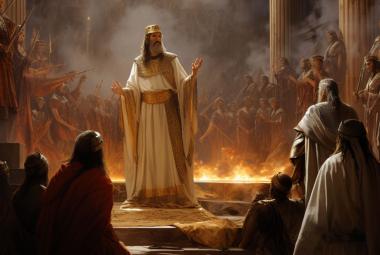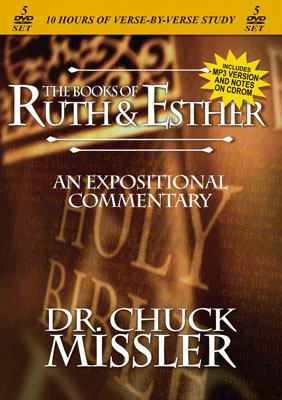The Book of Ruth
In many respects Ruth is the ultimate love story. It’s a love story because Ruth falls in love with Boaz—that’s the main plot line. But overlaying that is the ultimate love story, a love story written in blood on a wooden cross, erected in Judea two thousand years ago.
Ruth is one of the most significant books in the Old Testament for the Church. And it’s interesting that the book traditionally is read by rabbis on the Feast of Pentecost, when the Church was born. It explains, like no other book in the Scripture, the role and mission of the kinsman redeemer. I believe this book is an essential prerequisite to understanding the book of Revelation. Before you study Revelation 5, you need to understand the book of Ruth.
The events of Ruth take place in the days of the Judges. There was no king in Israel.
Chapter 1 is “Love’s Resolve,” where Ruth cleaves to Naomi. Chapter 2 is “Love’s Response,” Ruth’s gleaning. Chapter 3 is “Love’s Request,” a very unusual threshing floor scene. Chapter 4 is “Love’s Reward,” the redemption of both the land for Naomi and a bride for Boaz.
Let’s look at the book of Ruth from the perspective of a goel, a kinsman redeemer. What are the requirements for a kinsman redeemer? 1) He has to be a kinsman; 2) He must be able to perform; 3) He must be willing; and 4) He must assume all of the obligations.
So God has a goel for you and me. He has to be a kinsman of Adam; He must be able to perform. Revelation 5 is about the Seventh Sealed book, the Title Deed of the Earth. No man was found to claim it. It had to be a man. John sobbed convulsively because no man was found to redeem the earth. But wait! There is one who has prevailed to open the book and loose the seals thereof. “And I looked and behold; A Lion of the Tribe of Judah, the root of David, hath prevailed to open the book.” And that unfolds in the story of Ruth. It has to be a kinsman; he has to be able; he has to be willing; he must assume all the obligations; and indeed, He has. “It is finished,” He said.
Now, Boaz is the Lord of the harvest, but he is also the kinsman redeemer. So Boaz is a type or foreshadowing of Jesus Christ. Naomi typifies Israel. She was out of the land; through his redemption, she was brought back into the land. Ruth was the Gentile bride, a type of the Church.
In order for Ruth to be joined to Naomi, Naomi had to be exiled from her land. The nearer kinsman couldn’t take Ruth; it was against the law for an Israelite to marry a Moabite. But what the law could not do, grace did.
Incidentally, Ruth did not replace Naomi. They are different; they are distinctive. Israel and the Church are distinctive, with different origins and different missions. Ruth learned the laws of Israel through Naomi, a Jew. We Gentiles learn the ways of God by reading the Jewish Scriptures. We worship a Jewish King of a Church composed of Jewish leaders using a Jewish Bible as our authority.
In the threshing floor scene, no matter how much Boaz loved Ruth, it was her move. And according to the Law, Ruth should have gone to the nearer kinsman to make the proposal. But Boaz took it upon himself to be her advocate; he was her intercessor. He confronted the nearer kinsman.
The Book of Esther
The Book of Esther is another fascinating drama. Xerxes (or Ahaseurus) hosted a gigantic banquet with his queen, Vashti, who was apparently very beautiful. He requested that she expose herself immodestly to the guests, and she refused. As punishment, Ahaseurus dethroned her. A nationwide search was launched for a replacement for Vashti, and Esther, an orphaned Jewish girl raised by her cousin, Mordecai, was ultimately selected. A Jewish girl was now the queen of the Persian Empire! Mordecai warned her not to reveal her Jewish background.
Haman, the bad guy of the story, was a big shot, like a sheriff. (He was born because Saul failed to follow God’s instructions in 1 Samuel). Haman hated the Jews in general, but he hated Mordecai particularly because Mordecai refused to do obeisance to him. When Haman got promoted and Mordecai refused to bow down to him, his hatred became an obsession.
Haman’s hatred was so intense that he plotted to wipe out all the Jews. He’s almost like a foreshadowing of Hitler. Haman convinced the king that the Jews were enemies of the state and should be exterminated. Mordecai found out about the plan and prevailed upon Esther to intercede. He made it clear that if Haman was left to his devices, he would wipe out not just Mordecai, but the entire Jewish population in the Persian Empire.
He finally convinced Esther to intercede, and his argument to her is one you’ll hear echoed many times: “Thou art come to the kingdom for such a time as this.” He saw the hand of God, that Esther was the queen for the very purpose of thwarting Haman’s Satanic plan.
The problem was that the Persians were ruled by very strict laws that couldn’t be reversed, even by a capricious king. And part of royal protocol was if you entered the king’s throne room without having been summoned, you were subject to death. What Mordecai was asking Esther to do was dangerous. She had not been summoned by the king for over a month (he may have had other wives) and suspected she might be out of favor. But she ultimately yielded to Mordecai’s instructions and declared, “If I perish, I perish.” She did ask for three days of fasting and prayer before she approached the king, because it was going to be very risky.
The critical moment came when she entered the inner court. When the king saw her, he extended the scepter (meaning she was accepted). For some reason, rather than tell the king the problem immediately, she simply invited the king and Haman to a banquet. This deferral of the opportunity really set the stage for some other things because Haman was ecstatic: he was invited to a banquet with the king! To celebrate, he prepared a gallows to hang his enemy, Mordecai. (The language implies that he was not to be hung with a rope, but impaled.)
After the banquet, Esther invited them to yet another banquet. The deferral was used by God in some fascinating ways because while a gloating Haman was preparing the gallows for Mordecai, the king couldn’t sleep, so he decided to read the chronicles of what had transpired lately in the empire. He discovered something very troubling; he read that Mordecai had exposed a plot against the king’s life. The would-be assassins were executed, but there was a bureaucratic screw-up in that Mordecai was never rewarded. At the second banquet, the king asked Esther, “What is on your heart? What is your request? I’ll give you up to half the kingdom …”
She answered, “Only that mine and my people’s lives are spared.” And, of course, the king was shocked. As Esther explained the situation, the king was so astonished that he had to compose himself. He was so angry that he had to ponder the fact that he had been the pawn of Haman’s deceits. So he left the banquet to catch his breath before he reacted. While he was out of the room, Haman panicked. He knew his moments were numbered. He pled with Esther for his life and fell on the couch she was reclining on just as the king returned. He misconstrued (perhaps deliberately) what was happening: “You would attack the queen, also?” He ordered Haman hanged (or pierced) on the very gallows he had designed the previous night for Mordecai!
Ruth was a Gentile living among Jews; Esther was a Jew living among Gentiles, and each marries across ethnic boundaries into the royal line. Ruth emphasizes the sovereignty of God; Esther emphasizes the providence of God. Both stories demonstrate that “chance” is really God working undercover!







